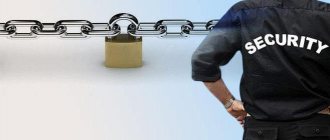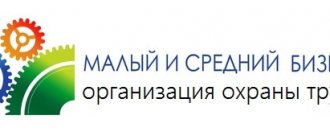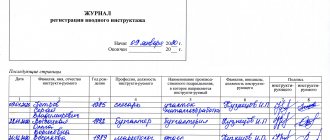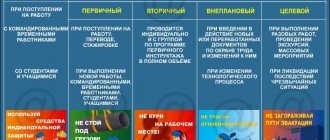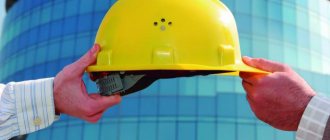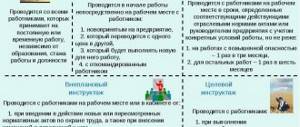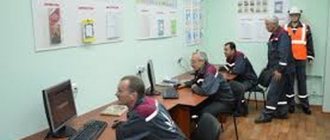06-12-2019
Current legislation obliges employers to take into account labor protection requirements and monitor their implementation. Moreover, in enterprises with more than 50 employees, a special labor protection service should be created. If the number of employees working in the organization does not exceed 50, then such a service is organized at the request of the manager - the director decides on its appearance at his own discretion. Usually in such a situation, the duties of a special group (special specialist) are performed by the boss himself. It is he who is responsible for all violations that may be revealed during the inspection (audit). Let's consider how the preparation of labor protection documents should be carried out correctly.
Comparative characteristics of internal audit and labor protection control
| Internal audit | Labor safety control |
| Audit results are sent to interested parties to enable timely and appropriate actions to be taken. | Address direction of the order |
| Audit results should not serve as a basis for holding employees accountable | Is the basis for holding workers accountable for identified violations |
Why audit working conditions, safety and health?
An audit of working conditions is an independent objective way to check the work of the labor protection sector, which allows you to identify inconsistencies in the activities of an enterprise from the point of view of laws.
Logo
A labor safety audit allows you to reveal all the imperfections in the protection system and organize improvement measures at the enterprise in accordance with the laws. An audit is a comprehensive check, which includes:
- audit of the turnover of all materials. The availability of all document flow in production regarding the field of labor protection is checked;
- checking acts and journals for compliance with these laws;
- monitoring the vital activity of the facility and proposals for optimizing working conditions;
- providing a detailed report on the inspected object;
- list of measures to eliminate nonconformities;
- recommendations for the implementation of mandatory actions.
Note! Recommendations are created taking into account labor costs for training, a special assessment of working conditions, legal requirements and other nuances.
Types of checks
There are two main types of inspections - scheduled and unscheduled. Planned ones differ in that they are carried out at certain time intervals. For each calendar year, a schedule is generated with a list of organizations to be inspected and the timing of inspection visits. This plan is published on the official page of the State Labor Inspectorate (GIT), and is also re-published on the official page of the Prosecutor General's Office of the Russian Federation.
The company is additionally warned about the scheduled inspection three days before it begins. The notification can be sent in various ways - by mail, fax, e-mail, courier delivery, etc.
During a routine inspection, the inspector is given the right to check a list of special control issues. They may relate to various types of regulations related to labor protection. This is determined by the goals and objectives of a particular inspection and is recorded in the order for its implementation.
From the beginning of spring 2021, the time intervals between scheduled inspections of an organization will depend on the risk category of its activities. For example, organizations whose activities are assigned a high risk group are subject to inspection once every two years, a significant risk group - once every three years, etc. If the risk level is low, scheduled inspections are not carried out at all.
Unscheduled inspections are carried out in situations where:
- there is an order issued by the head of the inspection, which is based on instructions from federal authorities or the request of the prosecutor's office.
- The time has expired to correct violations identified during the previous inspection.
- There is information that the requirements of labor legislation are being neglected in production (workers are not given wages, there is a risk of harm to the health of workers in production, etc.).
- the employee filed a complaint about neglect of his labor rights.
- a request was received from an employee to check the workplace.
Please note that the organization is notified of an unscheduled inspection one day before it begins. In a situation where an inspection of this kind is carried out due to the reasons specified in paragraphs. 3-4 lists, the inspector has the right not to notify the production manager about this. The time intervals between unscheduled inspections are not determined by law.
According to the law, anonymous applications are not considered, and the verification that began on such a request is terminated. Information about existing violations can be received by the inspectorate not only from employees, but also from the media, from other inspection bodies, trade unions, etc.
The benefits of internal audit
Independent fire risk assessment: safety audit of the Ministry of Emergency Situations
An occupational safety audit is not a prerequisite for enterprise management; the decision to schedule an audit is made individually by members of management. Occupational safety and health audits help the manager of an enterprise to obtain data on violations in this area and subsequently provide reports on ways to solve these problems to the owner of the facility.
An internal audit is a check of the structure that manages labor protection for smooth operation. Such checks need to be carried out constantly, this will allow:
- obtain timely information on the state of working conditions in the company;
- detect inconsistencies in the arrangement of work places and hazardous production factors;
- prepare for the audit of the state labor inspectorate;
- check the existing occupational safety management system;
- evaluate the actions of employees and identify the causes of traumatic situations at work;
- eliminate fines based on inspection results;
- pass quality control of authorized institutions.
Validation elements
Audit report on the results of the inspection
Based on the results of the audit, a corresponding document is drawn up - an audit report. He contains:
- information on the results of checking the availability of documentation required by the legislator and its contents;
- information on assessing the state of labor protection at the enterprise;
- references to the norms of current legislation that are violated by the enterprise;
- conclusions based on the assessment of financial, administrative and other risks that such violations entail;
- action plan aimed at eliminating identified violations.
***
So, an occupational safety audit can be external and internal. In the first case, the audit is carried out by specialists from a third-party specialized audit organization, and in the second - by employees of the enterprise itself. To conduct an audit, it is necessary to determine the directions of the audit, draw up working documentation, and, in accordance with the developed audit program, analyze the characteristics of each audited object. Based on the results of the procedure, a report is drawn up that contains the main conclusions obtained during the procedure, a list of identified violations/inconsistencies, as well as specific recommendations for their elimination.
Who can conduct an occupational safety and health audit?
Labor Safety Day in Organizations and Enterprises
Depending on the type of audit, members of the audit committee are selected. If there is an internal audit, the auditors are appointed by management. They can be employees who are specialists in the required field. If we are talking about an external inspection, then the commission should include specialists from third-party inspection institutions.
Requirements that each member of the audit committee must meet:
- higher or secondary specialized education;
- work experience in this field for at least three years;
- availability of a training program for an auditor in a minimum amount of 40 hours;
- the presence in the last three years of four full inspections (20 hours each) under the supervision of a more experienced worker.
Organization of control over the state of labor protection
Depending on the specifics of production and the structure of the enterprise, control can be carried out:
I. The first stage - managers of the first level of management - direct supervisors of work at production facilities and managers of production facilities (foremen, mechanics, power engineers, technologists, etc.) on a workshop site, construction site, in a shift or team.
II. The second level - managers of the second level of management - heads of departments (heads of departments and their deputies) in the workshop, on the construction site, in production or at the enterprise site.
III. The third stage - managers of the third level of management - managers and chief specialists of the organization (employer) at the enterprise as a whole.
Each level of control must be carried out at a certain level of management according to an established program within a specified time frame.
- Managers of the first level of management exercise control daily at the beginning of the working day (shift), and if necessary (work with increased danger, etc.) - during the working day (shift).
- Managers of the second level of management carry out control at least once a week , as a rule, with the frequency with which they are directly present at production facilities.
- Managers of the third level of management carry out control at least once a month .
The management of the control organization is carried out by the head of the enterprise. The results of the control must be recorded in specialized journals.
I. The first stage of monitoring the state of labor protection in the organization
At the first stage of control, it is recommended to check:
- implementation of measures to eliminate violations identified by the previous inspection;
- the condition and correct organization of workplaces (location and availability of the necessary tools, devices, protective devices, workpieces, etc.);
- condition of passages, passages, driveways;
- safety of technological equipment, lifting and transport vehicles;
- compliance with electrical safety rules when working with power tools and electrical installations;
- compliance with the rules for storing blanks and finished products;
- serviceability of supply and (or) exhaust ventilation, local suction, dust and gas collection devices;
- compliance with safety rules when working with harmful and fire-explosive substances and materials;
- availability and compliance by workers with labor protection instructions;
- availability and correct use of personal protective equipment by workers;
- availability of primary fire extinguishing means;
- workers have the appropriate certificates for the right to carry out certain types of work (work on lifting equipment, work with pyrotechnic tools, etc.).
Based on violations identified during the inspection, measures to eliminate them are planned, deadlines and those responsible for implementation are determined. If the deficiencies identified by the inspection cannot be eliminated immediately, then the head of the unit must, upon completion of the inspection, report this to a superior manager to take appropriate action.
If a gross violation of labor safety rules and regulations is detected, which could cause harm to the health of workers or lead to an accident, work is suspended until this violation is eliminated.
The results of the inspection are recorded in the log of the first stage of control, which should be kept by the head of the department.
Direct managers of facilities (heads of workshops, sections, etc.) at least once a week check the state of labor protection conditions in the workplace, as well as the work of work managers (foremen, foremen, etc.) to carry out the first level of operational control and take prompt measures to eliminate identified violations and shortcomings.
II. The second stage of monitoring the state of labor protection in the organization
At the second stage of control it is recommended to check:
- organization and results of the first stage of control;
- implementation of activities planned as a result of the second and third stages of control;
- execution of orders and instructions of the head of the enterprise and the head of the workshop, decisions of the trade union committee on labor protection issues;
- implementation of activities as prescribed by supervisory authorities;
- carrying out activities based on accident investigation materials;
- serviceability and compliance of production equipment, vehicles, technological processes with labor protection requirements;
- compliance with schedules of preventive maintenance of equipment, ventilation and aspiration systems and installations;
- condition of passages and galleries;
- the condition of corners and stands on labor protection, the presence of signal colors and safety signs;
- availability and condition of fire fighting equipment, escape routes;
- compliance with safety rules when working with harmful and explosive substances and materials;
- timeliness and quality of training of workers on labor protection;
- availability and correct use of personal protective equipment by workers;
- provision of workers with therapeutic and preventive nutrition, milk and other preventive means;
- condition of sanitary facilities and facilities;
- compliance with the established work and rest regime, labor discipline.
The results of the inspection are recorded in the second stage log, which should be kept by the workshop manager. In this case, the commission appoints activities, and the workshop manager appoints performers and deadlines.
If it is impossible to carry out activities by the workshop forces, the workshop manager is obliged to report this to a superior manager so that appropriate measures can be taken.
III. The third stage of monitoring the state of labor protection in the organization
At the third stage of control, it is recommended to check:
- organization and results of the first and second stages of control;
- implementation of activities planned as a result of the previous third stage of control;
- implementation of orders and instructions of higher economic organizations, resolutions and decisions of trade union bodies, orders and instructions of supervisory authorities, orders of the head of the enterprise and decisions of the trade union committee on labor protection issues;
- implementation of activities provided for by collective agreements, agreements, comprehensive labor protection plans and other documents;
- implementation of activities based on materials from the investigation of severe and group accidents and accidents;
- provision of workers with personal protective equipment, correct issuance, storage, organization of washing, cleaning and repair;
- preparedness of department personnel to act in emergency situations, etc.
The third stage of control is carried out by a commission headed by the manager or chief engineer of the enterprise and the head of the trade union organization at least once a month.
The commission includes the head of the labor protection service, the chairman of the labor protection commission, heads of technical services, the head of supervision of buildings and structures, and the fire chief (responsible for fire safety).
A large enterprise, the inspection of which is impossible in one round, is inspected in individual workshops (facilities) according to an annual schedule, drawn up in such a way that during the year each workshop is inspected at least four times, and workshops with increased danger and unfavorable in relation to labor protection - at least six times.
The commission of the third level of control can be divided into a number of subcommittees under the leadership of chief specialists or deputy chief engineers to conduct inspections of individual enterprise facilities.
The results of the inspection must be documented and discussed within a week at a meeting with the head of the enterprise with the participation of members of the labor protection commission of the trade union committee. All heads of workshops, sections, and services must be present at the meeting with the head of the enterprise. At the meeting, the heads of those workshops, sections, and services where an unsatisfactory state of labor protection has been identified are heard.
It is recommended that the meeting be documented in a protocol indicating measures to eliminate identified deficiencies and violations, deadlines and responsible persons. If necessary, the head of the enterprise issues an order based on the results of the inspection.
The monthly day of third-stage control may be referred to as “Labor Safety Day.”
Conducting an audit of occupational safety and health at an enterprise
Labor protection measures: plan at the enterprise
Audits are divided into planned and unscheduled. If the organization unexpectedly changes its manager, an unscheduled inspection is carried out.
An internal audit is carried out in 10 stages, which are necessary for representatives of the organization.
Inspector and personnel of an industrial enterprise
Stage 1. A special standard is developed, which specifies the nuances relating to this audit:
- personnel data. Appointment of personnel in the structure and job responsibilities of each;
- audit scheme;
- conditions for generating reports based on the results of the inspection and all details of the registration process;
- the measures in which the results obtained are adjusted, if necessary, are indicated.
Stage 2. The object of verification is indicated. It is determined in which direction the audit team will work:
- the possibility of injuries occurring at the enterprise is determined. The suitability of personal protective equipment is checked. It is determined whether there are shortcomings that lead to a lack of protection for the employee at his workplace;
- the maintenance of a log of safety briefings at the workplace is checked. Personal cards are also checked;
- the degree of readiness of employees for unforeseen circumstances (force majeure) is determined;
- the correctness of filling out all provided forms in the documentation is checked.
Stage 3. An audit program is developed. This task is usually dealt with by a commission created by management.
- A person responsible for labor protection is appointed.
- The documents that will be selected for checks are determined.
- Dates and frequency of reports are assigned.
Stage 4. This stage involves the creation of an administrative document on the conduct of an internal audit. If the inspection takes place at a structural unit, then the head of this unit must be familiarized with the order at least 10 days before the appointed date.
Stage 5. After the auditors have familiarized themselves with all the necessary documents, they need to begin creating special brochures that will serve as reminders for employees.
Stage 6. Direct start of the audit. The necessary data is collected and analyzed, taking into account all the nuances. An audit of working conditions and health safety can be carried out both during working and non-working hours with the consent of employees.
Note! The main goal of the auditor is to obtain reliable and accurate information on the objects being audited.
Stage 7. If inconsistencies are found during the audit, the audit team draws up a protocol of violations and a corresponding report.
Possible violations:
- training deadlines were violated;
- the enterprise manager does not have a document confirming his studies at a specialized educational institution;
- the company does not have the necessary employees who should have undergone training in a specialized educational institution;
- There is no fact that staff have completed a training course in this area.
All possible inaccuracies are entered into the violation protocol, observing the entire algorithm. It displays the time and number of the detected violation, its detailed description and significance. When the auditor prepares the general report, he must read out all identified inconsistencies to everyone present at the commission. The time for generating this report is established by law - one week.
Note! The management of the enterprise can develop a special unique form for providing such reports.
Stage 8. Meeting of heads of departments of the enterprise. It announces all the results of inspections and identified violations, proposes and records ways to eliminate these inconsistencies and the time required to implement these actions.
Stage 9. Opportunity to eliminate detected violations at the enterprise. A month is allotted for appropriate actions to implement corrective measures. However, if the enterprise has some special specifics, then the legislation provides for an extension of the period for eliminating existing violations.
Stage 10. Registration of the results of the internal audit of the organization in the register. It reflects all the necessary data, including information about the timing and timing of all stages and copies of documents.
For your information! When an internal audit of occupational safety and health at an enterprise is carried out regularly, and all detected inconsistencies are eliminated on time, subject to careful analysis by management, then the occurrence of injuries at this enterprise is minimal.
Check form
Both scheduled and unscheduled inspections can take two forms:
- documentary;
- away
The GIT auditor carries out a documentary check at his workplace. He requests from the company papers of interest to him that are relevant to the verification tasks. The company is given 10 days to fulfill the request. All documents are provided in the form of copies certified by the signature of an authorized person and seal, or in electronic form with a certified electronic signature. Attention: the inspector does not have the right to take away the originals or ask for notarization of documents.
If, during the inspection of documents, the inspector finds errors or inconsistencies in the information provided, he requires the organization to provide additional written explanations. The period for providing such explanations is 10 working days.
An on-site inspection is carried out at the location of the company, in production or in the office, when:
- the inspector needs to make sure that the submitted facts correspond to reality;
- it is necessary to assess whether the company's activities comply with legal requirements.
Where and how to record audit results
The result of checking working conditions is an audit report. It contains the following information:
- data on the availability of the required documents regulated by law at the inspected object;
- certification of the labor protection structure at the enterprise;
- if there are violations, appropriate links to laws with requirements are indicated;
- necessary measures to eliminate identified inconsistencies at the enterprise.
What document will the manager receive?
How to conduct an audit
To conduct a labor safety audit at an enterprise, it is necessary first of all to draw up a list of objects being inspected. An audit can be both targeted (when only one system object is analyzed) and comprehensive (when the functioning of the OSMS as a whole is studied).
The following areas are subject to an OSMS audit:
- Operation of the enterprise. In this case, a comprehensive analysis of the state of the industrial safety and health system is performed, for which the following is carried out:
- checking the documents for the equipment in use, including the availability of certificates for the personal protective equipment used;
- collection of information about the equipment of personnel with work uniforms and footwear with certain protective characteristics, as well as cleaning and disinfectants;
- checking existing safety instructions.
- The effectiveness of occupational safety measures. In this case, the following is investigated:
- the risk of employee injuries and occupational diseases;
- accident statistics.
- Work with personnel. During the research the following is carried out:
- testing of enterprise employees to determine the level of their knowledge in the field of safety;
- assessment of the degree to which they comply with the requirements of labor protection instructions.
Cost of occupational safety audit
The cost of services for auditing working conditions for safety and health varies from 20 thousand to 50 thousand rubles*, depending on the enterprise. The cost is affected by:
- the amount of work ahead;
- assigned tasks;
- area of conduct;
- number of staff;
- complexity and volume of documentation;
- specifics of the enterprise.
For example, an analysis of the necessary documentation, taking into account the issuance of an act and recommendations, will cost 8,000 rubles. Inspection of the premises system for compliance with labor legislation and sanitary and hygienic standards costs 15 rubles. for 1 m² of premises up to 500 m² and 10 rubles. with an area of more than 500 m².
If facilities comply with all legal requirements for the protection of working conditions, the risks of traumatic situations are reduced to zero. Also, do not neglect regular special assessments of working conditions. According to the law, such unscheduled assessments must be carried out before the expiration of six months from the day the new workplaces were put into operation.
*Prices are current as of July 2021.
Unscheduled inspections
The basis for an unscheduled safety inspection may be:
- expiration of the deadline for fulfilling an order previously issued by the State Tax Inspectorate;
- appeals from citizens, legal entities, individual entrepreneurs or information from executive authorities, local governments, trade unions, the media about violations of legal requirements that may cause harm to the life and health of workers;
- complaints filed and registered in accordance with the established procedure regarding violations of employee rights;
- an employee’s request to conduct an inspection of labor conditions and safety at his workplace;
- order (instruction) of the head of the State Tax Inspectorate in connection with the instructions of the President, the Government of the Russian Federation or the requirement of the Prosecutor's Office.
Employer's liability
Regardless of the form of ownership of the enterprise, the employer is responsible for:
- Ensuring the safety of workers in the workplace, including the operation of equipment, use of tools and materials.
- Providing employees with certified personal protective equipment.
- Organization of safe workplaces.
- Timely implementation of SOUT.
- Monitoring compliance with sanitary standards and medical care for workers.
- Organization of work and rest of workers in accordance with legislative acts.
If violations are identified, some time is given to eliminate them, and then a repeat inspection is carried out.
